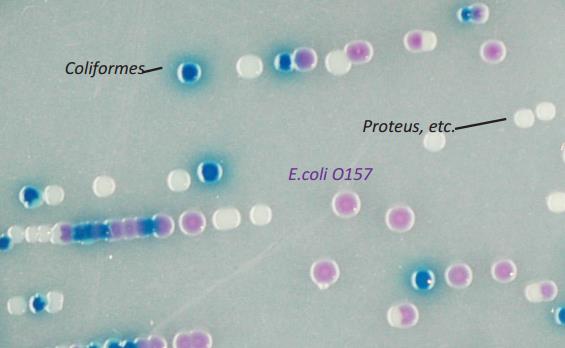Incidence of Escherichia coli 0157:H7 in feces of lactating ruminants with diarrheal syndrome
Incidencia de Escherichia coli O157:H7 en heces de rumiantes lactantes con síndrome diarreico

Show authors biography
Objective. To identify Escherichia coli 0157:H7 present in diarrheal feces of lactating ruminants with diarrheal syndrome and safety of colostrum intake. Materials and methods. A feces sampling of 316 ruminants was carried out during the period of August 2015 to March 2016 in the municipalities of Río Grande, General Enrique Estrada, Morelos and Calera de Victor Rosales of the state of Zacatecas, obtained from 67 cattle, 183 sheep and 66 goats. Results. The following were identified in CHROMagarTM chromogenic medium: 260 coliforms, 78 Escherichia coli 0157:H7, 16 Proteus spp. and 25 colonies of unidentified bacteria, finding an incidence of Escherichia coli 0157:H7 of 22.03% in the four municipalities. Conclusions. Escherichia coli 0157:H7 is the second bacteria found in ruminant feces with an incidence of 22%, which is a mortality risk factor in lactating ruminants (less than 21 days old), causing economic loss and health risk for the population of the state of Zacatecas.
Article visits 2042 | PDF visits
Downloads
- WHO. Zoonotic Non-0157 Shiga Toxin-Producing Escherichia Coli (STEC): report of a WHO scientific working group meeting, Berlin, Germany. (No. WHO/CSR/APH/98.8). Geneva: World Health Organization; 1998. https://apps.who.int/iris/bitstream/handle/10665/68880/WHO_CSR_APH_98.8.pdf;jsessionid=B1067243252676E852A98B9BF9EB08C3?sequence=1
- Méndez A, Maldonado A, Ruiz-Villamor ER, Moreno IL, Bautista MJ, Lorenzo B, et al. Enfermedades neonatales. [On line] Organismo De La Unidad Nacional De Ovinocultores: México; 2016. http://www.uno.org.mx/empezar/neonatales.html
- Macedo R, Arredondo V, Rodríguez J, Ramírez J, López, B. Efecto del sistema de producción, de la época de nacimiento y del sexo sobre la mortalidad neonatal de corderos Pelibuey. Trop Subtrop Agroecosyst. 2010; 12(1):77-84. http://www.revista.ccba.uady.mx/ojs/index.php/TSA/article/view/205
- Gebremedhin EZ, Agonafir A, Tessema TS, Tilahun G, Medhin G, Vitale M. et al. Some risk factors for reproductive failures and contribution of Toxoplasma gondii infection in sheep and goats of Central Ethiopia: a cross-sectional study. Res Vet Sci. 2013; 95(3):894-900. https://doi.org/10.1016/j.rvsc.2013.08.007
- Gould LH, Bopp C, Strockbine N, Atkinson R, Baselski V, Body B. et al. Recommendations for diagnosis of Shiga toxin-producing Escherichia coli infections by clinical laboratories. MMWR Recomm Rep. 2009; 58(12) 1-14. https://www.cdc.gov/mmwr/preview/mmwrhtml/rr5812a1.htm
- Gutierrez ME, Janes ME, Torrico DD, Carabante KM, Prinyawiwatkul W. Assessment of the ability of five culture media for the detection of Escherichia coli O157. Int J Food Sci Technol. 2016; 51(8):1910-1915. https://doi.org/10.1111/ijfs.13164
- Laven RA, Ashmore A, Stewart CS. Escherichia coli in the rumen and colon of slaughter cattle, with particular reference to E. coli O157. Vet. J. 2003; 165 78-83. https://doi.org/10.1016/S1090-0233(02)00162-4
- Bertin Y, Girardeau JP, Chaucheyras-Durand F, Lyan B, Pujos-Guillot E, Harel J. et al. Enterohaemorrhagic Escherichia coli gains a competitive advantage by using ethanolamine as a nitrogen source in the bovine intestinal content. Environ Microbiol. 2011; 13(2):365-377. https://doi.org/10.1111/j.1462-2920.2010.02334.x
- Cobbold RN. Rectoanal junction colonization of feedlot cattle by Escherichia coli O157:H7 and its association with supershedders and excretion dynamics. Appl Environ Microbiol. 2007; 73(5):1563-1568. https://doi.org/10.1128/AEM.01742-06
- Franz E, van Hoek AH, van der Wal FJ, de Boer A, Zwartkruis-Nahuis A, van der Zwaluw K. et al. Genetic features differentiating bovine, food and human isolates of Shiga toxin-producing Escherichia coli O157 in The Netherlands. J Clin Microbiol. 2012; 50(3):772-780. http://dx.doi.org/10.1128/JCM.05964-11
- Fratamico PM, DebRoy C. Detection of Escherichia coli O157:H7 in food using real-time multiplex PCR assays targeting the stx1, stx2, wzyO157, and the fliCh7 or eae genes. Food Anal Methods. 2010; 3(4):330-337. https://doi.org/10.1007/s12161-010-9140-x
- Vicente HIG, Amaral LA, Cerqueira AMF. Shigatoxigenic Escherichia coli serogroups O157, O111 and O113 in feces, water and milk samples from dairy farms. Braz J Microbiol. 2005; 36(3):217-222. http://dx.doi.org/10.1590/S1517-83822005000300003
- Hirvonen JJ, Siitonen A, Kaukoranta SS. Usability and performance of CHROMagar STEC in detection of Shiga toxin-producing Escherichia coli strains. J Clin Microbiol. 2012; 50:3586-3590. https://doi.org/10.1128/JCM.01754-12
- Etcheverria AI, Padola NL. Shiga toxin-producing Escherichia coli: factors involved in virulence and cattle colonization. Virulence. 2013; 4(5):366-372. https://doi.org/10.4161/viru.24642
- Caballero M, Rivera I, Jara LM, Ulloa-Stanojlovic FM, Shiva C. Isolation and molecular identification of potentially pathogenic Escherichia coli and Campylobacter jejuni in feral pigeons from an urban area in the city of Lima, Peru. Rev Inst Med Trop S Paulo. 2015; 57(5):393-396. http://dx.doi.org/10.1590/S0036-46652015000500004
- Heiman KE, Mody RK, Johnson SD, Griffin PM, Gould LH. Escherichia coli O157 outbreaks in the United States, 2003-2012. Emerg Infect Dis. 2015; 21(8):1293-1301. https://doi.org/10.3201/eid2108.141364
- Olvera A, Signorini M, Tarabla H. Escherichia coli verotoxigénica: modelo cuantitativo de exposición y escenarios de riesgos en canales bovinas en Argentina. Rev Panam Salud Pública. 2010; 27(6):403-413. https://doi.org/10.1590/S1020-49892010000600001
- Fox JT, Shi X, Nagaraja TG. Escherichia coli O157 in the rectoanal mucosal region of cattle. Foodborne Pathog Dis. 2008; 5(1):69-77. https://doi.org/10.1089/fpd.2008.0042
- Jacob ME, Callaway TR, Nagaraja TG. Dietary interactions and interventions affecting Escherichia coli O157 colonization and shedding in cattle. Foodborne Pathog Dis. 2009; 6(7):785-792. https://doi.org/10.1089/fpd.2009.0306
- Piedrahita D, Márquez T, Máttar S. Detección de Escherichia coli 0157: H7 en poblaciones porcinas, canal bovina y productos cárnicos en el departamento de Córdoba. Rev MVZ Córdoba. 2001; 6(2):119-126: https://doi.org/10.21897/rmvz.532
- Tang Y, Kim H, Singh AK, Aroonnual A, Bae E, Rajwa B. et al. Light scattering sensor for direct identification of colonies of Escherichia coli serogroups O26, O45, O103, O111, O121, O145 and O157. PloS One. 2014; 9(8):e105272. https://journals.plos.org/plosone/article?id=10.1371/journal.pone.0105272
- Parsons BD, Zelyas N, Berenger BM, Chui L. Detection, characterization, and typing of Shiga toxin-producing Escherichia coli. Front Microbiol. 2016; 7:478. https://doi.org/10.3389/fmicb.2016.00478























